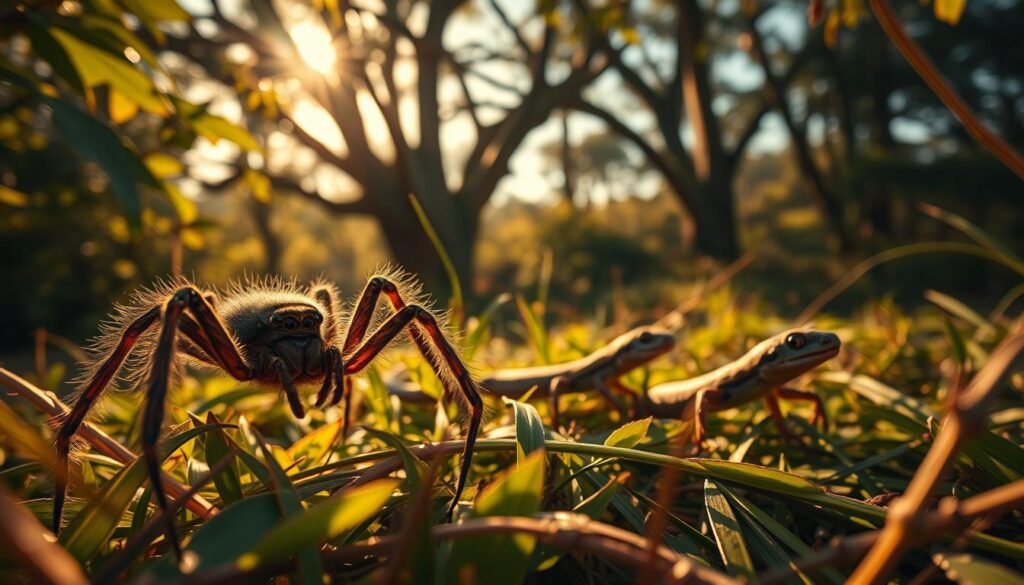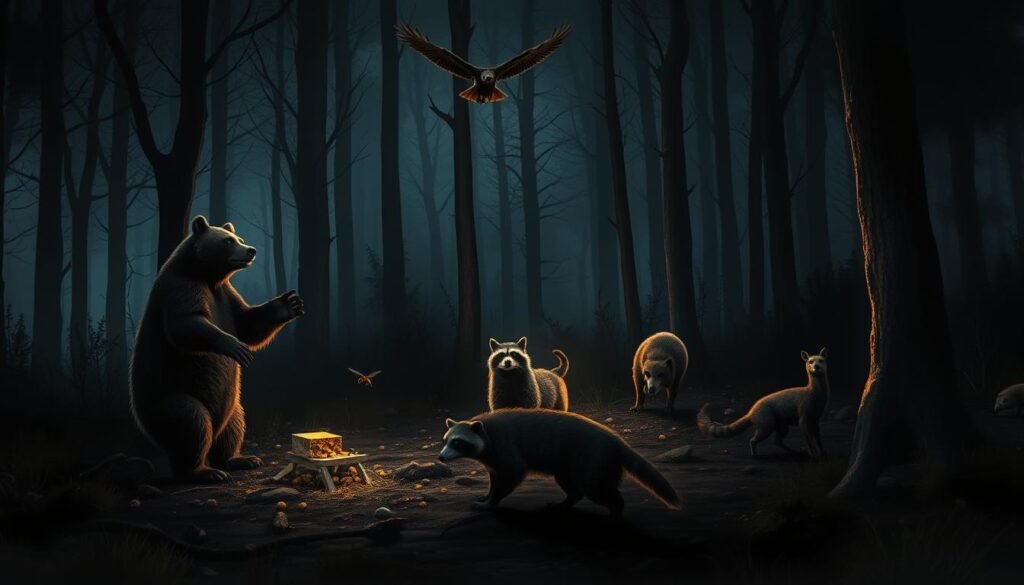Honey bees play a vital role in Australian ecosystems, yet they face constant pressure from natural predators. These industrious insects sustain diverse animals that have adapted unique strategies to exploit their colonies. From stealthy insect hunters to opportunistic birds, the list of predators reveals nature’s intricate balance.
Australian environments host both native and introduced species that target honey bees. Some attackers use brute force to raid hives, while others employ precision strikes mid-flight. This dynamic affects pollination patterns and agricultural outcomes, making predator awareness essential for conservation efforts.
Beekeepers frequently encounter unexpected threats to their colonies. Understanding these interactions helps develop practical protection methods while preserving ecological relationships. The adaptability of bee predators underscores the need for informed management strategies across urban and rural landscapes.
Key Takeaways
- Diverse predators target honey bees across Australian ecosystems
- Predation impacts pollination services and food production
- Specialised hunting methods range from solo ambushes to group raids
- Both native wildlife and invasive species pose risks
- Effective protection requires species-specific strategies
Introduction to Bee Predators in Australia
In Australia’s diverse landscapes, honey bees encounter relentless pressure from predators that disrupt hive stability. These threats range from opportunistic insects to larger animals, each exploiting weaknesses in colony defences. Balancing predator control with ecological preservation remains a critical challenge for conservationists and apiarists alike.
Seasonal Challenges for Hive Survival
Predator activity fluctuates with food availability, peaking during drier months when natural nectar sources dwindle. Wasps intensify raids on weakened hives, while birds target foraging workers. Strong colonies maintain vigilance through coordinated guard bees, but prolonged attacks can overwhelm even robust populations.
Ecosystems Rely on Resilient Bees
Healthy honey bee clusters sustain pollination networks affecting 75% of flowering plants. When predation reduces worker numbers, fruit yields drop by up to 40% in some crops. This ripple effect impacts native wildlife dependent on seed-bearing vegetation, highlighting the interconnectedness of ecosystems.
Australian agriculture relies on these pollinators for over $6 billion in annual production. Proactive hive management helps mitigate losses, ensuring both commercial viability and environmental balance. Understanding predator behaviour forms the foundation of sustainable beekeeping practices nationwide.
What eats a bee? Exploring the Predators
Australia’s buzzing pollinators face relentless threats from unexpected hunters. Creatures spanning four biological classes exploit colonies for nourishment, with tactics as varied as their habitats.

Mammals like honey badgers and raccoons tear through hive walls to access larvae and stored honey. These raids leave colonies vulnerable to secondary attacks from smaller animals. Birds employ precision strikes – swallows snatch workers mid-flight, while woodpeckers drill into nesting sites.
“Managing these predators requires understanding their habits,” notes a Victorian apiarist. “Each species demands tailored defences.”
Reptiles ambush sluggish foragers during cooler mornings. Insects pose stealthier dangers – wasps infiltrate hives to steal resources, and mantises ambush returning scouts. These interactions highlight bees’ ecological significance as both pollinators and prey.
| Predator Type | Primary Target | Hunting Method |
|---|---|---|
| Mammals | Honey stores | Hive destruction |
| Birds | Adult bees | Aerial interception |
| Reptiles | Foragers | Ambush predation |
| Insects | Larvae | Hive infiltration |
Effective protection combines physical barriers and habitat adjustments. Elevated hive stands deter ground-based predators, while modified entrances block smaller invaders. These strategies help maintain Australia’s crucial pollination networks.
Mammalian Menaces: Bears, Badgers, and More
Australia’s apiaries face relentless threats from powerful mammals seeking sweet rewards. These persistent invaders combine strength and cunning to breach hive defences, driven by the allure of honey and protein-rich brood. Their destructive raids leave beekeepers scrambling to reinforce protective measures.
Bears and Their Destructive Impact on Apiaries
Bears rank as the most formidable hive destroyers, capable of reducing wooden structures to splinters in minutes. A single raid can obliterate years of colony growth, with losses exceeding $5,000 per incident. Their exceptional memory ensures repeat visits to productive sites, often spanning multiple seasons.
Raccoons, Skunks, and Opossums: A Closer Look
Smaller mammals employ stealth tactics. Raccoons pry open hive lids with dexterous paws, while skunks leave telltale scratches near entrances from nocturnal feeding. Opossums snatch bees directly from landing boards, demonstrating nature’s opportunistic feeding strategies.
| Predator | Primary Target | Damage Signs |
|---|---|---|
| Bears | Honey & brood | Crushed hive boxes |
| Badgers | Entire hives | Overturned stands |
| Raccoons | Honey stores | Removed lids |
| Skunks | Adult bees | Entry scratches |
| Opossums | Foraging bees | Claw marks |
Effective deterrence requires tailored solutions. Electric fencing stops bears, while weighted lids thwart raccoons. Regular hive inspections help identify early signs of skunk or opossum activity before colonies suffer irreversible harm.
Avian and Reptilian Predators Around the Hive
Australia’s skies and undergrowth host skilled hunters that exploit bees as seasonal food sources. These predators employ tactics refined through evolutionary adaptation, striking when colonies appear most vulnerable.
Birds Targeting Honey Bees and Their Strategies
European honey buzzards dominate daylight hunts, plucking bees mid-air with acrobatic dives. Swallows perform precision strikes during flight, while woodpeckers breach tree cavities housing wild colonies. Smaller birds like chickadees switch to honey bees when seeds become scarce.
| Bird Species | Hunting Method | Success Rate |
|---|---|---|
| Honey Buzzard | Aerial ambush | 78% |
| Swallow | Mid-flight capture | 65% |
| Woodpecker | Cavity penetration | 82% |
| Chickadee | Opportunistic feeding | 43% |
Reptilian Encounters: Lizards and Snakes Near Hives
Garden-dwelling lizards snatch bees visiting flowers, using quick tongue strikes. Green anoles patrol flowering shrubs near hives, while garter snakes occasionally consume grounded workers. These reptilian predators rarely threaten entire colonies but contribute to daily losses.
Elevated hive placement reduces ground-based attacks. Beekeepers report 30% fewer lizard encounters when using raised stands with smooth surfaces. Such adaptations help maintain colony strength against diverse threats.
Insect Threats and Hive Pests
While external predators pose visible risks, Australian colonies face equally dangerous threats from miniature invaders. These insects and parasites exploit weaknesses in hive defences, often causing irreversible damage before detection. Their presence impacts honey production, comb integrity, and overall colony health.

Varroa Mites, Wasps, and Hive Beetles
Varroa mites rank as Australia’s most destructive hive pests, draining nutrients from adult bees and developing brood. These parasites transmit over 20 viruses while reproducing in sealed cells. Wasps escalate attacks during autumn, stealing honey stores and capturing workers to feed their larvae.
Hive beetles target stressed colonies, laying eggs that hatch into destructive larvae. Their activity ferments pollen reserves and spoils honey through bacterial contamination. Comb damage from beetle tunnels creates entry points for secondary infestations.
Other Insect Intruders and Their Effects
Wax moths infiltrate weakened hives, their larvae spinning silken tunnels through wax combs. This destruction compromises brood rearing and honey storage capacity. Tracheal mites invade breathing tubes of adult bees, reducing flight efficiency and lifespan.
| Pest | Primary Target | Damage Method |
|---|---|---|
| Varroa Mite | Brood & Adults | Virus Transmission |
| Hive Beetle | Honey Stores | Fermentation |
| Wax Moth | Comb Structures | Tunnel Networks |
| Wasp | Workers & Resources | Direct Predation |
Integrated pest management combines regular hive inspections with targeted treatments. Biological controls like predatory nematodes help manage beetle populations, while screened bottom boards disrupt mite reproduction cycles. Early intervention remains critical for preserving colony strength against these persistent threats.
Smart Strategies to Protect Your Apiary
Proactive defence measures shield colonies from Australia’s persistent predators. Modern solutions combine traditional methods with innovative technology, creating layered protection systems. Strategic planning reduces losses while maintaining hive productivity and ecosystem balance.
Preventive Measures: Electric Fencing and Hive Stands
Electric fencing delivers 90% effectiveness against large mammals when properly maintained. Beekeepers report 5000-7000-volt systems deter wombats and goannas best. Elevated stands lift hives beyond easy reach, with 18-inch heights blocking 70% of ground-based attacks.
Ratcheting straps prevent clever predators from dismantling stacked boxes. Combine these with perimeter fencing using poultry netting for skunk deterrence. Regular voltage checks ensure wires deliver consistent shocks throughout dry seasons.
Innovative Hive Entrances and Barrier Solutions
Modified entrances balance airflow and security. Metal reducers with 8mm holes let workers pass while excluding mice. Some beekeepers install rotating entrance discs that confuse persistent predators without restricting flight paths.
Hardware cloth skirts around hive bases deter burrowing animals. For wasp-prone areas, attach decoy feeders 50 metres from main colonies. These diversion tactics reduce pressure on primary hives during peak predation months.
Tips for Australian Beekeepers to Fortify Colonies
Local conditions demand adapted solutions. Use UV-stable wire for coastal apiaries and rust-proof components inland. Position hives near prickly native shrubs like grevilleas – their dense growth discourages casual intruders.
Monitor entrances weekly for scratch marks or displaced reducers. Replace damaged fencing immediately after storms. Share predator sightings through regional beekeeper networks to enhance community-wide protection efforts.
Conclusion
Australia’s honey bee populations thrive through careful management of their complex predator relationships. Diverse animals target colonies for nourishment, from hive-raiding mammals to nectar-seeking insects. Effective protection combines physical deterrents with ecological awareness, ensuring these vital pollinators continue sustaining ecosystems.
Strategic hive placement reduces ground-based attacks, while regular monitoring spots early signs of infestation. Apairists balance defensive measures with habitat preservation, recognising predators’ role in natural selection. This approach maintains healthy brood development and honey production cycles.
Sustainable practices help safeguard colonies without disrupting food chains. By understanding predator behaviours, Australians protect both agricultural interests and biodiversity. The future of honey bees depends on this delicate equilibrium between human intervention and wild ecosystems.




